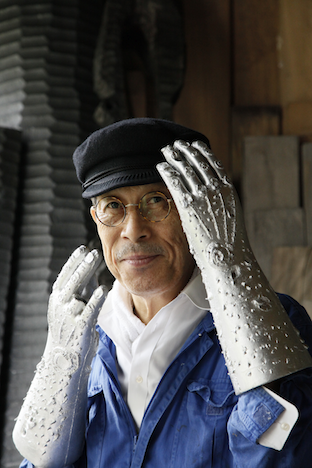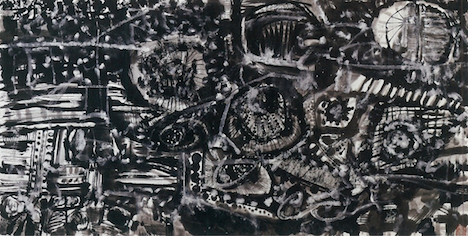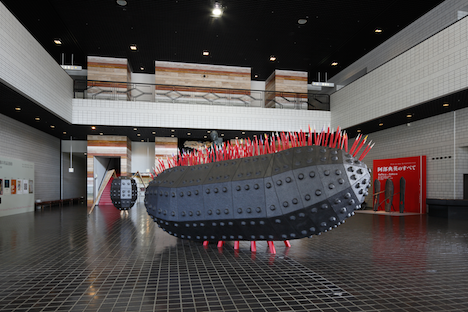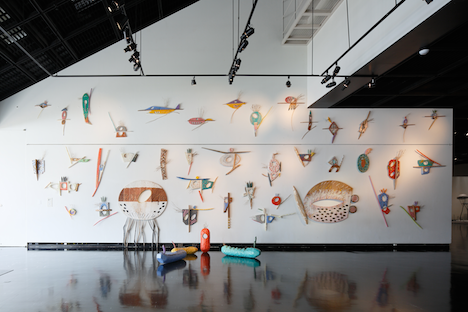TEN-EI ABE
PEOPLEText: Ayumi Yakura
Ten-ei Abe, a representative artist of Hokkaido, Japan, has stood in the front line for over 60 years. Since his debut, he has exhibited many outstanding dynamic pieces domestically and overseas and he still keeps developing new pieces, regardless of the achievement and evaluation.
This summer, a solo exhibition “A La Carte” composed of plane works is being held at Cross Hotel Sapporo. Also, Abe will hold a large-scale solo exhibition at the Heilongjiang Art Museum in Harbin City, China in the fall. This interview uncovers his view about masterpieces and new works born under the environment full of nature, where he moved to recently, and his future goal.

“The Hand” 1973, 120 x 125 x 438 mm and more (11 set), Aluminum, Photo: Koji Sakai
First of all, why did you decide to become an artist?
I’m not sure where to start, though…. When I was in the first grade of high school, I joined an art club and a calligraphy club. When I quit art club during the first term of the second grade, was when I decided to live as an artist.
A calligraphy teacher, Mr. Shusetsu Kano, saw my work and told me that I should express what I like. On the other hand, my art teacher forced me to do exactly as he taught and I guess he tried to teach me hard. So, I doubted the rule of art and expression.

Calligraphy in high school days, 1955-58, 690 x 1,340 mm India ink on Paper
For example, in the field of art, a person can reach the 55 steps by stepping up one by one. But, he can reach it even if he steps two at a time and goes back to the former step again. In the process of producing art, various ideas come up and sometimes make artists feel the need to study the basics again. I guess such things allow me to consider and produce freely, it just matches me.
Because I like pictures and colorful expressions, I decided to learn by myself and stick to art.

“Say, Darling or Stillness, Slow, Step” 2008-10, 2,100 x 5,500 x 2,300 mm, Wood, Pulp, Graphite, Synthetic resin, Vinyl acetate resin, “Ten-ei Abe Retrospective” 2012, Hokkaido Museum of Modern Art
What is the meaning behind the series, “Say, Darling”?
One of the meanings is an answer to my self-question about the way to express as an artist, Ten-ei Abe, not Norihide Abe. Another meaning is appealing to people to see my silly works. Also, the title itself was quoted from John Steinbeck’s novel, Of Mice and Men, who won a Nobel Prize for literature.
It was in 1965 when I first exhibited “Say, Darling”. When the Vietnam War had begun, I thought how people started killing again. I had a terrible experience when I was forced to evacuate to the countryside during World War II. My father was taken as a prisoner in Siberia, and my family and I lived for three years without a father. So, it includes the theme of anti-war.

“Bride” series, 1988-, Wood, Bamboo, Acrylic paint, “Ten-ei Abe Retrospective” 2012, Hokkaido Museum of Modern Art
Please tell me about “Bride”.
When I created a coal-black piece “MUKUJIN” and “Say, Darling” series in a farmer’s house of Otoineppu (North part of Hokkaido), I often burn the rest of the lumber to warm myself. Then, I heard a voice “don’t burn us” from the lumber. I painted Liquitex, which I usually use for sketching, on the woods and put them together. It was pretty interesting and I made more.
“Darling (husband)” could be understood as Adam. So, I chose the title “Bride” understood as Eve because it was made of the lumber from “Darling”.
Read more ...





